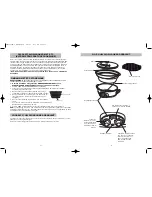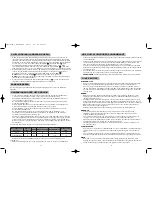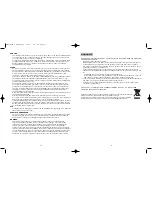
-6-
•
ALWAYS turn off your slow cooker, unplug it from the electrical outlet, and allow it to cool before
cleaning.
•
The lid and slow cooker stoneware can be washed in the dishwasher or with hot, soapy water. Do
not use abrasive cleaning compounds or scouring pads. A cloth, sponge, or rubber spatula will
usually remove any residue.
To remove water spots and other stains, use a non-abrasive cleaner or vinegar.
•
The lid will not withstand sudden temperature changes. Do not wash the lid with cold water when
it is hot.
•
The outside of the heating base may be cleaned with a soft cloth and warm, soapy water. Wipe
dry. Do not use abrasive cleaners.
CAUTION
: Never immerse the heating base in water or other liquid.
HOW TO CLEAN YOUR SLOW COOKER
HINTS AND TIPS
•
If you are converting a recipe that calls for uncooked noodles, macaroni, or pasta, cook them on
the stovetop just until slightly tender before adding to slow cooker.
•
If you are converting a recipe that calls for cooked rice, stir in raw rice with other ingredients; add
60 ml extra liquid per 60 ml of raw rice. Use long grain converted rice for best results in all-day
cooking.
BEANS
•
Beans must be softened completely before combining with sugar and/or acidic foods. Sugar and
acid have a hardening effect on beans and will prevent softening.
•
Dried beans, especially red kidney beans, should be boiled before adding to a recipe. Cover the
beans with three times their volume of unsalted water and bring to a boil. Boil 10 minutes, reduce
heat, cover and allow to simmer 1
1
⁄
2
hours or until beans are tender. Soaking in water, if desired,
should be completed before boiling. Discard water after soaking or boiling.
•
Fully cooked canned beans may be used as a substitute for dried beans.
VEGETABLES
•
Many vegetables benefit from slow cook times and low temperatures and are able to develop their
full flavor. They tend not to overcook in your slow cooker as they might in your oven or on your
stovetop.
•
When cooking recipes with vegetables and meat, place the vegetables in the stoneware before
the meat. Vegetables usually cook slower than meat in the slow cooker.
•
Place vegetables near the sides or bottom of the stoneware to facilitate cooking. Stir in chopped
or sliced vegetables with other ingredients.
•
Because eggplant has a very strong flavor, you should parboil or sauté the eggplant before adding
it to the slow cooker.
LIQUIDS
•
It is not necessary to use more than 120 to 240 ml liquid in most instances since juices in meats
and vegetables are retained more in slow cooking than in conventional cooking.
•
When converting conventional cooking recipes to slow cooking recipes, use about half of the
recommended amount of liquids, except in recipes that contain uncooked rice or pasta.
MILK
•
Milk, cream, and sour cream break down during extended cooking. When possible, add during
last fifteen minutes to half hour of cooking, until just heated through.
•
Condensed soups may be substituted for milk and can cook for extended times.
HINTS AND TIPS
-5-
SLOW COOKING
1. Insert slow cooker stoneware into the heating base, place your food into the stoneware, and plug
in the unit. Turn the temperature dial to the desired setting. Your slow cooker has three
temperature settings. LOW (
I
) is recommended for slow “all-day” cooking. One hour on HIGH (
II
)
equals about 1
1
⁄
2
to 2 hours on LOW (
I
). WARM (
) (display on LCD=
) is ONLY for keeping
already cooked food at the perfect serving temperature until you are ready to eat. DO NOT cook
on the WARM (
) setting. Always cook with the lid on when using your stoneware in the slow
cooker heating base.
2. Turn the timer dial to the desired cooking time. The time displays in the panel and starts to count
down. The cooking time options range from 30 minutes up to 20 hours, in 30 minute intervals.
When the cooking time has completed, the slow cooker automatically shifts to the WARM (
)
setting.
NOTE:
We do not recommend using the WARM (
) setting for more than 4 hours.
NOTE:
If you do not set the timer, the slow cooker will run at the temperature setting you chose
until you turn it off .
3. When cooking is done, turn the temperature dial to OFF (
) and unplug the unit from the outlet.
Allow the slow cooker to cool before cleaning it.
ROASTING/BROILING
The slow cooker stoneware can also be used as a traditional roasting pan in your oven.
USAGE NOTES
•
If there is a power outage, the food may be unsafe to eat. If you are unaware of how long the
power was out, we suggest you discard the food.
•
Always cook with the lid on for the recommended time. Do not remove the lid during the first two
hours of cooking.
•
The removable slow cooker stoneware is ovenproof and microwave safe. Refer to chart below.
•
Always use pot holders or oven mitts when handling the stoneware and when moving the slow
cooking base. The handles will become hot when in use.
•
ALWAYS use a trivet or hot pad underneath the heated stoneware, when placing on tables or
countertops.
•
Removable stoneware and lid are safe for use on stovetops*, in conventional and microwave
ovens, as well as in the refrigerator. NEVER freeze water or waterbased foods in the stoneware.
•
Due to the unique manufacturing process of the slow cooker stoneware, you may see variations in
the glazed surface. This is normal and does not affect performance.
•
Unplug when cooking is done and before cleaning.
•
Do not reheat foods in your slow cooker. Use oven, stovetop, or microwave to reheat.
Always use the heat diffuser when cooking on an electric stove.
Part
Dishwasher
Safe
Oven Safe
Microwave
Safe
Stove Top
Safe
Broiler Safe
Lid
Yes
Yes
Yes
Yes
Yes
Stoneware
Yes
Yes
Yes
** Yes
Yes
* The heat diffuser must be used when cooking on electric stovetops (coil or ceramic).
** Place the stoneware on one of the large burners on Low or Medium settings only.
SCVI600BS-I_07MLM2.qxd 9/3/07 3:17 PM Page 7





































